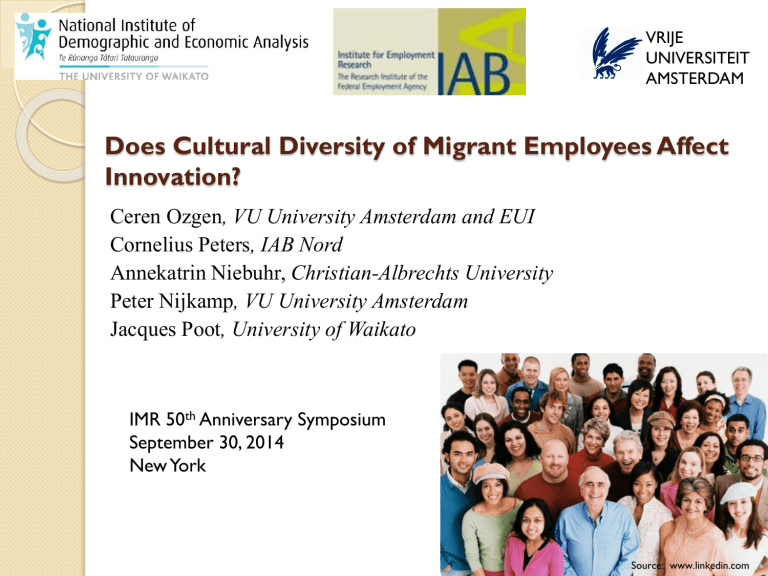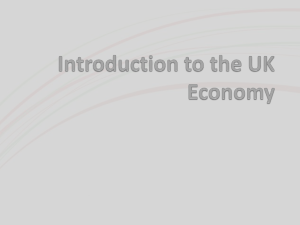Does Cultural Diversity of Migrant Employees Affect Innovation?

VRIJE
UNIVERSITEIT
AMSTERDAM
Does Cultural Diversity of Migrant Employees Affect
Innovation?
Ceren Ozgen , VU University Amsterdam and EUI
Cornelius Peters , IAB Nord
Annekatrin Niebuhr, Christian-Albrechts University
Peter Nijkamp , VU University Amsterdam
Jacques Poot , University of Waikato
IMR 50 th Anniversary Symposium
September 30, 2014
New York
Source: www.linkedin.com
2009-2013 PROJECT:
MIGRANT DIVERSITY AND REGIONAL
DISPARITY IN EUROPE (MIDI-REDIE)
Part of:
NORFACE Research Programme on Migration http://www.norface-migration.org/
MIDI-REDIE: Team Composition
Department of Spatial Economics, VU University Amsterdam, The Netherlands
Institute for Employment Research (IAB), Nuremberg, Germany
Institute for Social and Economic Research (ISER), University of Essex, UK
Labour Institute for Economic Research, Helsinki, Finland
Department of Economics, University of Tartu, Tartu, Estonia
MIDI-REDIE research on the impact of immigration on innovation
Key question: Does the presence of migrants from a diverse range of backgrounds in a region, or within a firm, boost innovation and productivity?
Various projects
◦ Meta-analysis of empirical literature (productivity effect)
◦ Pan-EU regional level (patents effect)
◦ Linked employer-employee panel data (innovation effect)
◦ Global macroeconomic panel data (productivity effect)
The IMR paper:
◦ Synthesis of existing literature
◦ Comparative German-Dutch analysis with harmonized data and (almost) identical modelling
Source: http://www.elegran.com/edge/2011/12/jane-jacobs-and-new-york-city-part-2
Positive and negative channels of diversity’s impact on innovation
Positive
◦ Within the organisation
Positive self-selection
Knowledge spillovers and networks
Enhanced decision-making and resilience
Migrants reducing business constraints through filling vacancies
◦ Externalities
Cultural diversity as an amenity
Agglomeration benefits
Benefits from the strength of weak ties and bridging social capital
Negative
◦ Within the organisation
Fractionalization (affecting communication, trust, treatment, mobility)
Greater labor intensity of production discourages adoption of new technology
◦ Externalities
Sorting and segregation
Bonding social capital, potentially leading to polarization
Fragmentation in representation
Measurement of cultural diversity
Cultural diversity refers to the extent of cultural differences among members within a social unit, i.e. it is a multidimensional concept
Indicators may include birthplace, ethnicity, race, language, ancestry, religion, etc.
The growing complexity of demographic composition in most cities is referred to as “superdiversity”
Common measures include the share of “foreigners”, the fractionalization index, the entropy index, the number of groups present (“cultural richness”)
The mathematical and statistical issues of measurement of diversity continue to attract considerable interest
A synthesis of the evidence to date
Major differences between North-American and
European literatures
Strong evidence of spillover benefits from foreign students and researchers
On balance, positive effects of cultural diversity on patent applications and innovation
Cultural diversity matters, but is of relatively less importance for innovation than e.g. business size and industry
Many studies are not able to adequately address the difficult issue of reverse causality: intrinsically innovative firms and regions may disproportionally recruit or attract workers from diverse backgrounds
Construction of harmonized Dutch and German datasets
Netherlands:
Community Innovation Surveys
(CIS)
Tax registers (SSB_Banen)
Municipal registrations (GBA)
Regional statistics from Statistics
Netherlands
Data coverage: 2002 & 2006
Germany:
IAB Establishment Panel (1% of all establ. & 7% of all employees)
Establishment History Panel (BHP)
IAB Employee History Panel (comes from Fed Empl Agency’s social security registers)
Regional statistics from Federal
Statistics Office
Data coverage: 2001 & 2004 & 2007
Panel of firms:
2 wave balanced panel of ~2800 firms for Dutch firms
3 wave balanced panel of ~1012 firms for German firms
Only private sector establishments
Some descriptive statistics
Product innovation
Fractionalization index
Foreignness indicator
Establishment size
Share of high-skilled
Share of <25 years old
Share of 25-45 years old
Share of high skilled foreigners *
Share of foreigners <25 years old*
Share of foreigners 25-45 years old*
Observations
* Only establishments employing foreign workers
Mean (St. dev.)
The Netherlands Germany
0.250 (0.433)
0.538 (0.295)
0.882 (0.321)
171 (354)
0.235 (0.165)
0.079 (0.090)
0.603 (0.137)
0.212 (0.247)
0.062 (0.141)
0.648 (0.265)
5586
0.442 (0.497)
0.109 (0.234)
0.314 (0.464)
123 (563)
0.068 (0.137)
0.069 (0.103)
0.551 (0.188)
0.067 (0.209)
0.075 (0.187)
0.579 (0.352)
3036
Results
A coefficient of about 0.1 for the diversity effect on innovation in both countries, but not statistically significantly in Germany
We can’t detect an effect of increasing diversity within firms over time, probably because the change in firm employment composition over 4-6 years is so small
Firm characteristics that drive innovation are the same in both countries
Skills matter – applies equally to migrants and natives
Addressing reverse causality
It is difficult to conceive and implement “randomized trials” in this context
Econometricians therefore use instrumental variables (IV) techniques that
◦
Identify and use factors that can explain observed cultural diversity within a firm
◦ But these factors should have no direct link with a firm’s innovation
Firms are expected to mostly employ people from their own vicinity, so IV reflect this:
◦
For the Netherlands: the number of unique countries of birth in the municipality where the firm is located
◦
For Germany: the average cultural diversity in similar firms in other regions
With this technique, the impact is now statistically significant and even larger in Germany (coefficient 0.4), but no longer in the
Netherlands
Conclusions
Firm size, sector, location and staff skills matter most for innovation
There is a small positive effect of cultural diversity, but to quantify it remains challenging
Replication across a wider range of countries is desirable
Cross-disciplinary integration of team diversity and innovation studies could be fruitful
◦ Consider organizational structures, institutional settings, types of tasks, etc.
This could help to identify the specific “channels” of impacts of cultural diversity on innovation
In turn, this may assist in designing effective policy responses
http://blogs.sap.com/innovation/human-resources/how-to-effectively-create-workplace-diversity-01242727
Thank You!
jpoot@waikato.ac.nz











